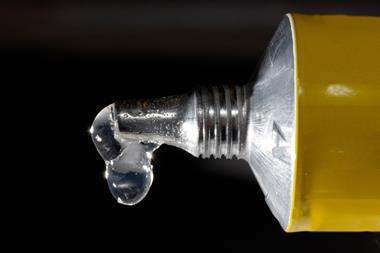Analysis of three types of mucus produced by garden snails has revealed the subtle differences in proteins, ions and glycans that dictate their contrasting properties. It is hoped the findings will aid the design of biomimetic synthetic mucus for healthcare and cosmetics applications.
Snail mucus and cosmetic products derived from it are a $12 billion (£9.6 billion) industry, and this mucus is also being investigated for joint lubricants, surgical adhesives and drug delivery, among other applications. However, uncertainty surrounding its composition has complicated efforts to exploit its properties.
The researchers, based at City University of New York in the US, collected mucus from the garden snail Cornu aspersum. This species secretes three types of mucus – one that hydrates and protects its skin, another that acts as an adhesive glue and a lubricant that lets the snail glide across a surface.
To explore the structure–function relationships of the three types of mucus, the researchers applied a systematic comparative ‘mucomic’ analysis combining genetic, chemical and material studies.
Comparison of these datasets was then used to reveal how C. aspersum exploits differential protein expression and how the composition of the mucus contributes to its role. The researchers found that adhesive mucus can stretch and self-heal because of the hydrogen bonds, ion bridges and disulfide linkages that form reversible crosslinks, allowing dynamic sol-gel transitions without sacrificing material properties.
In contrast, C. aspersum lubricating mucus was stiff, due to a high concentration (~40%) of collagen, and minimally adhesive due to linear structures along its axis of motion that reduce surface roughness and, in turn, friction.
Finally, they found the snail’s protective mucus combined features from the adhesive and lubricating mucus, resulting in a hybrid material with the stickiness of the adhesive mucus and the rigidity of lubricious mucus.
‘What we found was incredible,’ Adam Braunschweig, a materials scientist and organic chemist and one of the researchers on the study, told Chemistry World. ‘We found 71 different proteins… [and] expression of calcium is really key. Calcium crosslinks a lot of the glycosylated proteins in the mucus, so if you have a lot of calcium in there, it makes the chain stick together, and it’s more adhesive and less lubricating.’
Braunschweig’s team also identified a previously unreported protein class. ‘We discovered proteins that we called [conserved anterior mollusk proteins] that have a head and a tail region. The head is conserved and is used for integrating [the proteins] into the mucus gel and the tail has a specific function,’ he adds.
Braunschweig says the findings could enable the creation of synthetic mucus as a ‘superior and tailorable substitute for the natural material’.
Alan Gunn, a biologist at Liverpool John Moores University who has previously explored the antimicrobial properties of the defensive mucus produced by the brown garden snail, describes the study as ‘highly detailed’ but says he is unsure of how the findings will be applied. ‘It is interesting, and useful but whether it is truly novel is another matter: there doesn’t appear to be an overriding aim. Yes, differences between mucus types are detected but are they relevant?’ he asks.
‘The authors discuss [the] three types of mucus as though they are totally separate entities. In truth, what they are collecting will be a combination of secretions of several glands, the combination of which varies with the region of the snail.’
‘Whatever one collects, it is always going to be a combination of glandular secretions the properties of which will depend upon the abundance and level of stimulation of the various glands. The levels and constitution will also be impacted by how hydrated the snails are: poorly hydrated snails tend to produce less defensive mucus.’
However, Gunn added that the findings did provide a basis from which other studies could be developed.
References
A Cerullo et al, Nat. Commun., 2023, 14, 5361 (DOI: 10.1038/s41467-023-41094-z)

















No comments yet